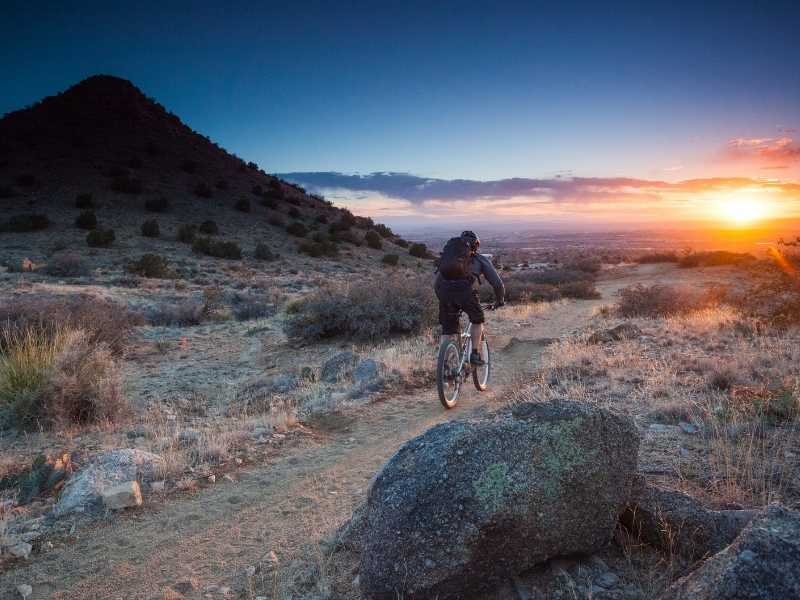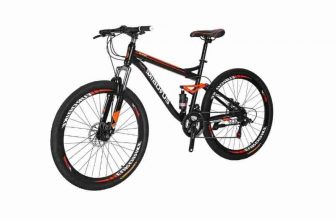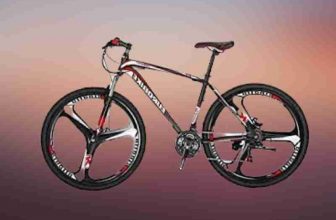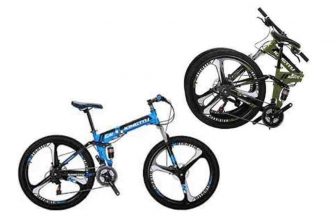
Bikes have become more functional, reliable, and enjoyable to ride in the last decade. That’s partial because, as bike manufacturers expand their offerings to cater to the different ways people love riding, the diversity has grown from a few basic styles (e.g., road, mountain, and city) to encompass all manner of niches and categories-within-categories.
Choosing the best mountain bike may appear to be a difficult task. The sheer number of different bike models can be intimidating, not to mention the confusing array of technology and vocabulary that surrounds them. Use this helpful guide to learn what makes a mountain bike unique and why you should buy one.
What Makes a Mountain Bike Unique?
A mountain bike is a bicycle made for riding off-road. Mountain bikes are similar to conventional bicycles in appearance. Still, they have features meant to improve durability and performance in rugged terrain, making them heavier, more complex, and inefficient on smooth surfaces.
Besides their broad, flat handlebars, they are equipped with knobby tires with ample tread, wide drivetrains with hydraulic disc brakes, and feature knobby tires with knobby tread for traction. The earlier 26-inch wheels are quickly becoming obsolete; 27-inch and 29-inch wheels are now the norm. There is a women’s-specific seat, smaller grips, narrower handlebars and shorter crank arms on women’s bicycles.
Lighter suspension settings are usually available for smaller riders. Lightweight bikes have become more popular with rear suspension, which is standard on heavy-duty bikes. The addition of dropper posts lets the rider change the seat’s height (an elevated seat position makes pedaling easier but can be dangerous in aggressive moves).
Bicycles designed for mountain biking can be used on non-paved surfaces such as mountain trails, singletrack, and fire roads. Mountain bike terrain is characterized by rocks, roots, loose dirt, and steep hills.
Technical trail features (TTF) include log piles, log rides, rock gardens, skinnies, gap jumps, and wallrides on many trails. Mountain bikes are designed to handle the terrain and features like these. This bicycle is also popular with people who live in cities and have to ride over potholes and curbs because it has a strong frame and bigger tires.
There Are Several Types of Mountain Bikes
As their name implies, hardtails are bikes with suspension forks and stiff frames. The least expensive of these is the standard, but high-end racing models are also available.
For XC Full-Suspension, it features an elongated rear suspension that travels a shorter distance (110 mm or less) for greater efficiency while cycling uphill.
Trail Full Suspension: A mid-travel suspension with 120mm-150mm of travel to balance climbing efficiency and descent capability. Tires get bigger, and brake rotors are more significant to provide more stopping power. Models come with plus-size 27.5×3-inch tires or traditional 29-inch wheels.
Full-Suspension Enduro/Gravity: These bikes are built with 160mm or more of rear-wheel travel, powerful brakes, and aggressive tire tread to handle steep, rough terrain.
MTB cycling is a type of mountain biking
Many new subtypes of mountain biking have emerged since the advent of MTB cycling mountain biking in the 1970s, including cross-country (XC), enduro, all-mountain, freeride, downhill, and a variety of track and slalom varieties. Each of these places unique demands on the bike, necessitating special design considerations for best performance.
MTB advancement has increased suspension travel, often up to 8 inches (200mm), and gearing up to 13 speeds to aid climbing and quick descents. Advances in gearing have also resulted in the widespread use of “1x” drivetrains (pronounced “one-by”), which reduce gearing to a single chainring in the front and a wide-range cassette in the back, generally with 9 to 12 sprockets. It doesn’t matter that 1x gearing reduces the bike’s weight and improves ground clearance because 2- or 3-ring drivetrains are still common on entry-level bikes.
Why Is Mountain Biking So Expensive?
Buying a mountain bike is not cheap. These geared machines might be costly nowadays. Mounted bikes are expensive because of their high-quality components and technology; some can cost up to $13,000. A good bike part needs to be durable and withstand hammering to keep you safe when riding. Cheap mountain bikes can be pretty dangerous; they’re prone to breaking frames, wheels, and handlebars.
Purchasing an expensive mountain bike appears more appropriate for competitive mountain cyclists than recreational mountain riders. It’s not for the price but for the technology to help you perform better.
While a 500-dollar mountain bike is not inexpensive by any means, it is in no way comparable to a $5,000 mountain bike. However, every biker prefers their activity to be done safely and with fun, which almost always entails a premium. Consider buying a used mountain bike; mountain bikes lose a lot of value in the first year, and a good bike can usually be had for half the price.
Mountain biking’s health benefits
Outdoor recreational sports such as mountain biking have been popular for several decades. According to the Outdoor Industry Foundation, almost 40 million Americans ride mountain bikes each year.
If you’re overweight or have heart disease or diabetes, physical activity outside is becoming more critical to your well-being.
Regular fitness and cardiovascular exercise have many health benefits, including mountain biking and a fun and enjoyable way to get those benefits.
Improved Cardiovascular Health
Regular exercise improves cardiovascular fitness. According to a study by the British Medical Association, almost half the risk of coronary heart disease can be reduced by cycling at least 20 kilometers a week.
The muscles you work while mountain biking require a lot of oxygen, which results in your heart working longer, improving fitness by 3–7 percent.
Diseases are less likely to occur
Maintaining a healthy immune system is believed to be boosted by doing moderate exercise regularly. Scientists at the University of North Carolina have reported that people who cycle for 30 minutes five days a week take half the number of sick days off work as those who sit at their desks. A study in the European Journal of Epidemiology found that women who do a lot of exercises, like cycling to work, have a lower risk of getting breast cancer.
Joints are less stressed
Mountain biking is a low-impact sport, making it easier on the joints than other cardiovascular exercises like running. Cycling is also a non-load-bearing sport, which means the act of sitting relieves pressure on your joints and lowers your chance of injury.
Stress is lessened, and your mood is lifted
Your body releases natural endorphins due to mountain biking’s strenuous demands. You feel good and get a lot of energy from these endorphins. Serotonin, another brain molecule that helps prevent depression and anxiety, is also increased by exercise.
By diverting your attention away from the unpleasant feelings and thoughts that lead to depression and anxiety, challenging singletrack can serve as a form of meditation and help you relax. Learning new skills and improving your mountain biking abilities will help you boost your self-esteem and confidence.
Improved Coordination and Balance
A rider is constantly challenged by changing terrain, pitch, and height compared to trudging on a treadmill or stepper. Maintaining your balance while mountain biking prevents you from falling, strengthening your neural connections, and strengthening your muscle memory.
The brain, senses, muscles, and nervous system contribute to balance and coordination. People who keep these systems going as they get older can lessen the damage caused by falls and lessen the effects of getting older.
Increased Mental Capacity
According to Illinois University researchers, cycling improved cardio-respiratory fitness by 5%, which resulted in a 15% improvement in mental tests. This is partly due to the hippocampus—the memory-related brain region—forming new brain cells.
According to Professor Arthur Kramer, “it improves blood flow and oxygen to the brain, which causes receptors to fire and regenerate, explaining the benefits of exercise in preventing Alzheimer’s.”
During their workout time, creative professionals and executives often use their sharpened brain functions to develop new ideas and solve problems.
Workout for the Whole Body
Mountain biking engages all of your muscles, so you may not realize cyclists have well-defined calves. Cycling contributes to developing a firm butt and strengthening your legs, thighs, and calves. Your abdominal and core muscles are maintained due to the balance required to stay upright. Your upper body is also strengthened through climbing and maneuvering turns. As well as giving you a good workout, mountain biking is also a cheap alternative to gym memberships and personal trainers.
Social Advantages
Happiness psychology, a newer field, has discovered that healthy relationships and social interactions are essential for happiness and meaning in life. Mountain biking is a popular social sport for clubs and individuals who come together to ride. It’s a great way to build friendships and make new friends with people who share your interests.
Better Sleep
After a ride, you may feel fatigued and worn out right away, but it will eventually lead to better restorative sleep when you need it at night. Riding helps us sleep better by lowering cortisol, a hormone that keeps us up.
Mountain biking is an outdoor exercise that exposes you to daylight, which helps to preserve the body’s normal circadian sleep/wake cycle while also increasing vitamin D production. Make sure you don’t go for a spirited ride too late in the day, as this can cause the release of stimulating endorphins, which can keep you awake.
Take pleasure in Mother Nature
Can the great outdoors be better enjoyed by consuming some dirt and getting up close and personal with thorny shrubs? However, mountain biking provides you with a better opportunity to escape the beaten path and appreciate the beauty of nature than any other activity.
According to Japanese researchers, spending time in nature (“forest bathing”) promotes relaxation and reduces stress. The opposite effect is experienced in a densely populated city, which increases the brain’s anxiety and fear centers. Being more environmentally aware and kind can come from spending more time on your bike.
As Freddy Mercury said, “Get your bikes and go,” instead of watching the football game and pulling out a beer. There is no better approach to improving your physical, mental, and emotional health is concerned.
The Negatives
There are a few disadvantages to touring on a mountain bike. Many of these can be fixed with a few simple changes, but some are more difficult because an MTB isn’t meant to go on long trips.
There are MTBs suited for the roads and touring, but I’m guessing most people don’t have multiple MTBs, and if you did, you wouldn’t be here.
Saddle soreness is real, and it hurts when you ride for 10 hours straight. Before your extended tour, make sure to break into your saddle and ride as much as possible. Getting used to riding in a saddle will save you a lot of grief and suffering. Wear seamless pants to avoid friction; otherwise, your legs will begin to ache!
They don’t come with mudguards, so acquire a pair of long mudguards to protect your back and face from dirt and water. I wouldn’t say I like getting mud in my mouth; the sand can linger on my tongue for hours.
On lengthy flat rides, the suspension may be a disadvantage. They’re designed to absorb shocks from pebbles, bumps, and tree roots while reducing impacts from rough terrain. A lockout feature on modern suspension forks disables the suspension.
Your weight also affects the amount the suspension goes up and down. Although it isn’t a significant disadvantage, a firm fork is likely to be more comfortable on flat routes. It could be replaced with a stiffer fork, but make sure it will fit by asking your bike shop.
Are mountain bikes sufficient for long-distance travel?
Mountain bikes are ideal for long routes and off-road rides since they allow you to travel long distances without sacrificing durability or functionality. When riding mountain bikes on pavement, you may find that you are peddling harder but not going any quicker. Mountain bikes are noted for their long lifespan. After all, a bike that can navigate bumpy roads and mountain trails should be challenging and dependable. Mountain bikes also have a lower weight, making it easier for riders to climb and navigate unpaved roads.
Mountain Biking in Challenging Terrain: How Difficult Is It?
Mountain bike paths frequently have sudden, steep climbs, but road gradients are softer and more steady. However, as mountain bike paths can be flat, roadways can feature steep gradients and fast reversals. A mountain road ride is unquestionably more challenging than a railroad-grade trail MTB ride.
Mountain riding has obstacles that you won’t find on the road, with terrain that might be unpredictable and constantly changing. Learning to master your shifting, cornering, braking, and balance on a mountain bike, for example, takes time and practice, as does navigate highly challenging terrain.
Technical terrain includes loose boulders, a steep drop, and a small route with sharp turns, which can be dangerous if you aren’t confident in your bike handling. While becoming comfortable dealing with these situations takes time and practice, there are some things you can do to stay safe and make the most of your time on the path.






